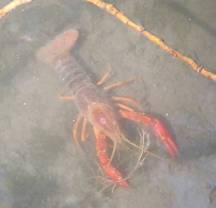Crayfish
Pacifastacus leniusculus
NATIVE

Crayfish
Pacifastacus leniusculus
NATIVE |
|
|
Chinese Mitten Crabs
Eriocheir sinensis NON NATIVE The Mitten crab is native to the Far East coastal rivers. Males have a large mitten-like covering on their claws. They have migrated to North American and Europe mainly through ships. They live mainly in fresh water, but spend much of later life in tidal or estuarine environments. They breed in the marine environment. |
|
Arthropods (Insects)
|
|
Order: Diptera
These are one of the
largest group of flies. The larvae tend to be oblong, cylindrical
and somewhat tapered toward the head. The head is retractable and
only partially hardened.
True flies lack jointed legs. some
have complete, exposed head capsules; others have a reduced retracted
head. The bodies are soft and flexible. |
|
Order
Coleoptera Riffle
beetles are small, dark colored and tend to like to hide under the small
rocks of riffles. The larvae
are adapted to cling to smooth rocks in flowing water.
After the larva turn into and adult beetle it flies for a short
time and then returns to the water to feed. |
|
|
|
Order:
Trichoptera All caddisflies have hard-shelled head
capsules. Sometimes the first three segments behind the head also
have hard-shelled plates on the top surface above the attachments for
three pair of legs. The rest of the body is soft and often
cylindrical. The larvae possess two small hooks on the last segment.
Some species are free-living while others make case retreats out of silk,
sand grains, pebbles, or bits of plant material. Caddisflies undergo complete metamorphosis and the larvae transform into winged adults in the water. As adults, caddisflies only live a few days and do not eat at all.several finger-like lobes |
|
|
Order:
Plecoptera Stoneflies are indicators of good water quality because the nymphs require highly oxygenated water. They tend to inhabit clear cold streams, and are highly intolerant of changes in water quality. Stoneflies undergo incomplete metamorphosis. The aquatic nymphs transform directly into winged adults. The heads and top surface of the first three body segments on nymphs are hardened. Their antennae are moderately long to long, and all species have exactly two tail filaments. Stonefly nymphs have
gills around the base of their legs or no gills at all. |
|
|
Order:
Ephemeroptera Mayflies are usually easy to identify. The nymphs can be small and squat, or long and slender. They have three pairs of segmented legs and visible antennae. They are most easily identified by their three tail filaments (although they may have 2), and by the seven pairs of abdominal gills found on most species. The gills may be either flat and spade shaped, or feathery in appearance. Mayfly nymphs are often flattened or streamlined to reduce the force of fast currents. They are most abundant in clear streams, though a few kinds may be found in other habitats. |
|
Order:
Odonta Dragonflies and
damselflies are predators. Their nymphs are not common in fast
moving streams, but may be abundant in sluggish waters. They may be
elongated and are a somber grey, green, or brown color. The body may
be smooth or rough and is often covered with a growth of algae and organic
debris. |
|